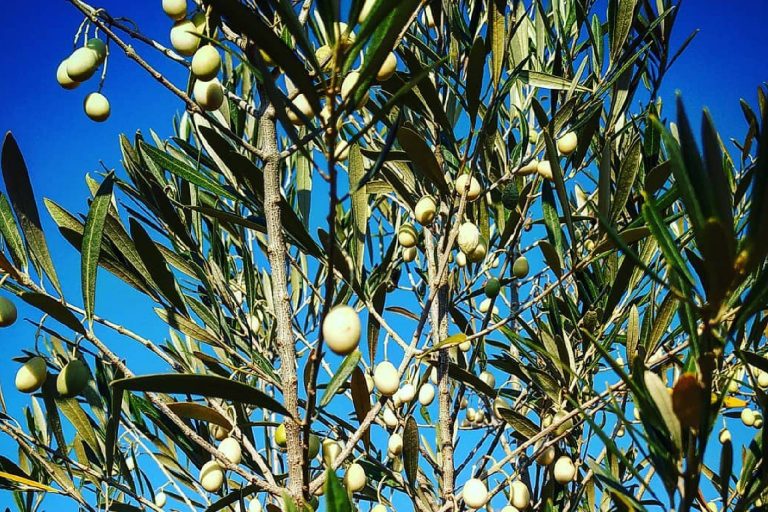Calabria is one of the most significant olive farming regions in Italy, where you can find a variety of unique native olive cultivars, including the rare white olive. Roughly 90 percent of their olives grown are used to make olive oil. While table olives, which make up the remaining 10 percent, are consumed. The standard types of olives available in the market are black and green.
But did you know there’s an olive that is so rare you can’t even buy it from any market, but only in a particular region of Italy like Calabria? And if you are wondering if that even exists, the answer is yes, it does exist. And that is what Calabrians usually call the “ancient rare white olives.” Read until the end to discover more about this olive tree’s roots.
What are white olives?
Leucocarpa, also called leucolea, is an olive variety characterized by small fruits that take on an ivory-white color during ripening. It is a well-known ancient rare Italian olive variety popular in Calabria and Southern Italy. Aside from the tiny size of its fruits, it is also famous for its ivory-white color after maturing. With that, white olives stand out from the others.
Where are white olives from?
White olives can be found in their home country of Greece, “Magna Graecia” or Greater Greece. They are also found in more southerly parts of Italy, in Tuscany, and especially in Calabria, as well as some areas along the Mediterranean coasts of northern Africa, Portugal, Malta, all the way west to the Atlantic shores.

The origins of white olives
The history of the mystical white olive starts with the colonization of the ancient Greeks to the Magna Graecia, Southern Italy. But generally, the discovery of these olive trees started way Back in A.D. 800 when the Greek Basilian monks had a strong drive in crops like white olive trees. And they used the crops primarily for various religious ceremonies and rituals.
The oil of the leucocarpa, also known as “Crisma’s oil,” was applied in religious ceremonies to bless priests. For instance, high Byzantine imperial officials used these oils in rites for the crowning of emperors. Aside from that, these oils are considered sacred in holy sacraments like baptism, confirmation, and purifying the sick.
What causes the olives to turn white?
Although white olives are indeed a rare beauty, many are still curious about why they are white or how they even became white. Thankfully, researchers are also interested and did their thing.
According to research, the process of olive ripening includes two phases. First is the method and synthesis of chlorophyll that drives the olive to turn green during the 1st phase. Then, after that is the degradation of chlorophyll, which will cause the olive fruit to lose its color during the 2nd phase.
And once the anthocyanins and other flavonoids activate, it shifts the olive fruit into blackish or bluish.
But a researcher said that the activation of anthocyanins and flavonoids does not happen in the cultivation of white olives. For this reason, they are the only type of olive that stays with a white color at any ripening stage.
Significance of leucocarpa to the locals
Ever since ancient times up until today, the mystical white olive trees have been a treasure for Calibrians. Thanks to the Leucocarpa trees’ deep and rich history, the Environmental Councilor of the Regional Council, Sergio De Caprio, decided to make this olive tree the symbol of their region.
The tree of white olive represents the nature of Calabrians, which shows the union and the legitimacy of the entire region. It simply shows how Calibrians value and honor these trees in their history.
Additionally, the regional government decided to protect the kinds of white olive trees. And then promote Calabria’s origins. Those ivory-white colored olives show a deep connection with their sacred history. At the same time, the tree radiates a great sense of beauty and purity.

The musical white olive at present times
Compared to the situation of these white olive trees in ancient times, the number of trees has decreased. And climate change is one of the most prevalent factors influencing and affecting that matter.
Most white olive trees are now threatened by climate change, which causes wildfires, drought, and even olive fruit pest invasions. That is why some people are raising awareness about this issue to save the oldest trees while, at the same time, working to grow new ones.
With the help and collaboration of various Calabrian churches, organizations, and growers, more than 200 white olive trees have been planted and continue to increase. With that, these sacred trees will continue to survive as the years pass.
The rare ancient white olive of Calabria
You can say that these so-called mystical white olive trees are not only famous for their crops, but they also come with a rich, deep history and sacred origin. Because of the story of these ivory-white colored crops, they have attracted the attention and interest of many people.
Thus, the rediscovery of these white olive trees became a big deal. Although they face challenges today, these white olive trees will continue to exist as time progresses with the support of Calabrians valuing these trees.
Follow us on Twitter, Facebook, or Pinterest

